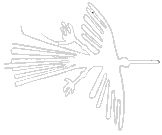|
| INKA
CUZCO also Cusco and Qosco |
| Pachacuti the 9th Inca [1438-1471] is credited with planning Cuzco to lay within the simple outline of a puma, or mountain lion, largely formed by the existing landscape. He probably used clay models for the plan and chose the puma for its place in Inca lore. Some Spanish chroniclers of the 16th and 17th centuries identified the city with a puma and in the 1960s Dr.Chávez Ballón from the National University of Cuzco, was the first to notice how the animal shape could be traced in the surviving Inka walls. Certainly, some existing place names support the idea. For example, the narrowest part of Inka Cuzco, today a lower part of the city is still known as Pumajchupan or Puma's Tail. The head was the hill with the monumental fortress-like walls of Sacsayhuaman. One of the two focal points of Inka Cuzco was the central square, the Haucaypata, which in Quechua means 'Leisure pata'. Pata has no easy translation and perhaps is best described simply as 'place'. This place formed the puma's breast in Pachacuti's plan and was a great ceremonial centre where every day physically perfect llamas were sacrificed at dawn, noon and dusk. Four roads from the distant parts of the Tawantinsuyu - the four quarters of the Inka realm converged on the Haucaypata which in the Inka mind was also the spiritual heart of the empire. The city was a government and ceremonial centre in which fewer than 4000 are thought to have lived. Outside the principal area in the surrounding valley another 100,000 people worked the land and were available for construction work such as the building of Sacsayhuaman. |
| From Qosco, The Navel of the World , © Tony Morrison, ISBN 9972-648-00-1 |
